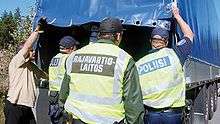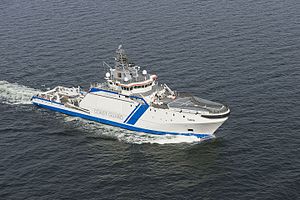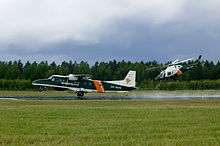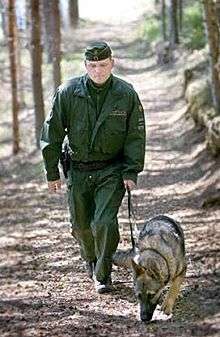Finnish Border Guard
The Finnish Border Guard (Finnish: Rajavartiolaitos; Swedish: Gränsbevakningsväsendet) is the national security agency responsible for enforcing the security of Finland's borders. It is a military organisation, subordinate to the Ministry of the Interior in administrative issues and to the President of the Republic in issues pertaining to the president's authority as Commander-in-Chief (e.g. officer promotions). The Border Guard has police and investigative powers in immigration matters and can independently investigate immigration violations. The Border Guard has search and rescue (SAR) duties, both maritime and inland. The Guard operates SAR helicopters that are often used in inland SAR, in assistance of a local fire and rescue department or other authorities.
| Finnish Border Guard Finnish: Suomen Rajavartiolaitos Swedish: Finska Gränsbevakningsväsendet | |
|---|---|
 Finnish Border Guard emblem | |
 Ship racing stripe | |
| Agency overview | |
| Formed | March 21, 1919 |
| Employees | 3,800 career personnel, mobilised strength 12,600 |
| Jurisdictional structure | |
| Operations jurisdiction | Finland |
| Specialist jurisdictions |
|
| Operational structure | |
| Elected officer responsible | |
| Agency executives |
|
| Child agencies |
|
| Website | |
| www | |




The border guard's active duty personnel consists of 3,800 men and women. The Finnish Border Guard has also 500 conscripts who are not used for border control during peace time. Upon mobilisation the Border Guard would be wholly or partly incorporated into the Finnish Defence Forces and its strength increased with reservists who have served their conscription in the border guard. The mobilised strength of the Border Guard is 12 600 servicemen. The Finnish-Russian border is actively monitored and patrolled by the Border Guard. The western sea borders and the western and northern land borders to Sweden and Norway are free to cross under the Nordic passport union, however the Border Guard does maintain personnel in these regions owing to its SAR duties.
There is a separate Finnish Customs agency, and immigration is handled also by the local police and Finnish Directorate of Immigration. PTR (police, customs and border guard) cooperation is well-developed and allows the authorities to conduct each other's duties as necessary.
Duties and jurisdiction
Main duties of the Finnish Border Guard:
- Protecting the land borders and territorial waters of Finland from unauthorised encroachment.
- Passport control at border crossing points, airports and ports.
- First line of defence against territorial invasions
- Rescue operations (mainly at sea and in the remote areas of Lapland).
- Provide aid to other authorities such as the Fire Department in case of unusual events like wild fires.
- Investigation of crimes pertaining to border security.
- Aiding Police forces in civil duties such as crowd control and riot control.
- Military operations pertaining to internal security.
- Customs control in the minor border crossing points without customs authorities.
- Training of conscripts for wartime duty. These include rajajääkäri (border jaegers) and erikoisrajajääkäri (special border jaegers).
- (during wartime) Long range patrols and guerrilla tactics behind enemy lines.
For the discharge of its duties, the Border Guard has limited police powers in the areas where it operates. It can, for example, seize and arrest persons and conduct searches in apartments and cars pursuant to same legislation as the police, when investigating a crime. However, the power to arrest a person has been delegated only to the commanding officers of a border control detachments and commanders and vice-commanders of larger units.
The Border Guard is not supposed to be used for the keeping of public order under normal circumstances, but it has two readiness platoons that can be used to support the Police in exceptional situations in matters of crowd control and internal security (including incidents involving dangerous armed criminals).[1] The readiness platoons have been used to supplement riot police during high-profile international events where there is a perceived danger of violent demonstrations, e.g. during the "Smash ASEM" demonstration in 2006.[2] However, the main duty of the readiness platoons is to handle the most demanding border security incidents.[1] Border Guard helicopters have also been used to assist police and rescue authorities in various missions.
The Border Guard also has the power to keep public order in its own facilities and in their immediate vicinity. For the execution of its military exercises, any officer with the minimum rank of Captain can close an area temporarily.
The Border Guard is responsible for enforcing the 3–5 km border zone towards Russia and issues the permits to visit the zone.
Organisation
Administrative units are responsible for the functions of the Border Guard. These administrative units are the Border Guard Headquarters, Southeast Finland, North Karelia, Kainuu and Lapland border guard districts, the Gulf of Finland and West Finland coast guard districts, Air Patrol Squadron and Border and Coast Guard Academy.
Training
The basic training of presumptive border guards is located to Imatra and is given in Finnish. Formerly courses were held also in Swedish in Espoo. The sea training for coast guards is located to Turku, where about half of the teachers have Swedish as their mother tongue, but also here the education is in Finnish, except some shorter courses. This is a problem especially for people from the Åland Islands, who often are not capable of completing an education in Finnish. Traditionally the proportion of Swedish speaking was high in the coast guard, and command of Swedish is important as the archipelagoes and coasts have a high proportion of Swedish speakers, some of which do not understand Finnish, and there are many vessels from Sweden in the Åland Islands and in the Archipelago Sea.[3]
Equipment
Watercraft
The Border Guard operates:
Small arms
Light weapons:
- Rk 95 Tp
- Heckler & Koch G36
- Heckler & Koch MP5
- Heckler & Koch UMP
- Glock pistols
- TRG-42
- Walther P99
Aircraft

The Border Guard operates 14 aircraft, including 12 helicopters. The AB 412s are to be replaced by new twin-engined helicopters, while the Super Pumas and Do 228s are being modernized.
| Aircraft | Type | Versions | In service[8] | Notes |
|---|---|---|---|---|
| AgustaWestland AW119 | utility helicopter | AW119Ke | 4 | built by Agusta |
| Bell 412 | transport helicopter | AB 412 AB 412EP | 4 1 | built by Agusta |
| Eurocopter Super Puma | transport helicopter | AS 332L1 H215 | 1 4 | Three older helicopters will be modernized to the same H215 standard as the two newer helicopters by 2020.[9] |
| Dornier Do 228 | maritime patrol aircraft | Do 228-212 | 2 |
History

After the Finnish Civil War in 1919, the control of the Finnish borders was given to the former Finnish Russian frontier troops under the command of the Ministry of Interior. Until 1945, only the Russian border was supervised by the Frontier Guard, the Swedish and Norwegian borders having only customs control. In 1929, a separate Sea Guard was founded to prevent the rampant alcohol smuggling caused by the Finnish prohibition of alcohol (1919–32).
At the start of the Winter War there were nine Border Companies (Rajakomppania) on the Karelian Isthmus. North of Lake Ladoga the Frontier Guards were combined into six Detached Battalions (Erillinen pataljoona). Further north in Petsamo the defence was left to the 10th Detached Company (10. Erillinen komppania). After the war marshal Mannerheim awarded all frontier guards the title "Border jäger" (Rajajääkäri). During the Continuation War, the Frontier Guard companies were combined into 12 Border Jäger battalions (Rajajääkäripataljoona) and later during the Lapland War into a Border Jäger Brigade (Rajajääkäriprikaati).
Current activities
After the Second World War, the Border Guards were placed on all Finnish borders. In 1950s, the Sea Guard was attached to the Border Guard. Since then, the Border Guard has received a fine public image. It is famed for the wilderness skills of its guards foot-patrolling the forest-covered Russian border, its good efficiency in catching the few illegal border crossers and for the fact that it is the only state authority in large parts of Lapland. In these matters it resembles the popular image of the Royal Canadian Mounted Police. The Border Guard of Finland is one of the links of the chain of protectors of the external borders of the European Union and Schengen agreement. Moreover, Border Guard officers also have to be very fluent in the Russian language.
Nearly every Border Guard District trains small number of conscripts for long range reconnaissance (Finnish: Sissi). Conscripts in Border Guard companies are mostly volunteers and preferably selected from the occupants of border areas, and while trained by Border Guard, they do not perform regular border control duties. Rivalry between Sissi from Border Guards and Defence Forces is traditionally high.
Employment in Border Guard is much sought for, especially in North and Eastern Finland, which suffer from chronic unemployment problems. Typically a vacancy in the Border Guard receives at least 50 applications.
See also
- Crime in Finland
- Finnish Security Intelligence Service
- Frontex (The European Agency for the Management of Operational Cooperation at the External Borders of the Member States of the European Union)
- Law enforcement in Finland
- National Bureau of Investigation (Finland)
- Police brutality in Finland
- Police of Finland
References
- Valmiusjoukkueet. Finnish Border Guard. Retrieved 2015-07-07. (in Finnish).
- Smash ASEM: mielenosoitus joka ei koskaan alkanut. Yle Elävä arkisto. 10.1.2012. Retrieved 2015-07-07. (in Finnish)
- Lindberg, Camilla, ed. (2020). Ett rum för alla – Folktingets arbete för svenskan i Finland under 100 år (in Swedish). Helsinki: Swedish Assembly of Finland. ISBN 978-952-9700-61-5.
- "Griffon 2000TD". www.griffonhoverwork.com.
- "Watercat 1300 Patrol". www.marinealutech.com.
- "RV90". tyovene.com.
- "The Border Guard's vessels and aircraft". www.raja.fi.
- "World Military Aircraft Inventory", Aerospace Source Book 2007, Aviation Week & Space Technology, January 15, 2007.
- "Ensimmäinen retrofit Airbus Helicopters H215 Super Puma Suomeen". raja.fi (in Finnish). 4 June 2019.
